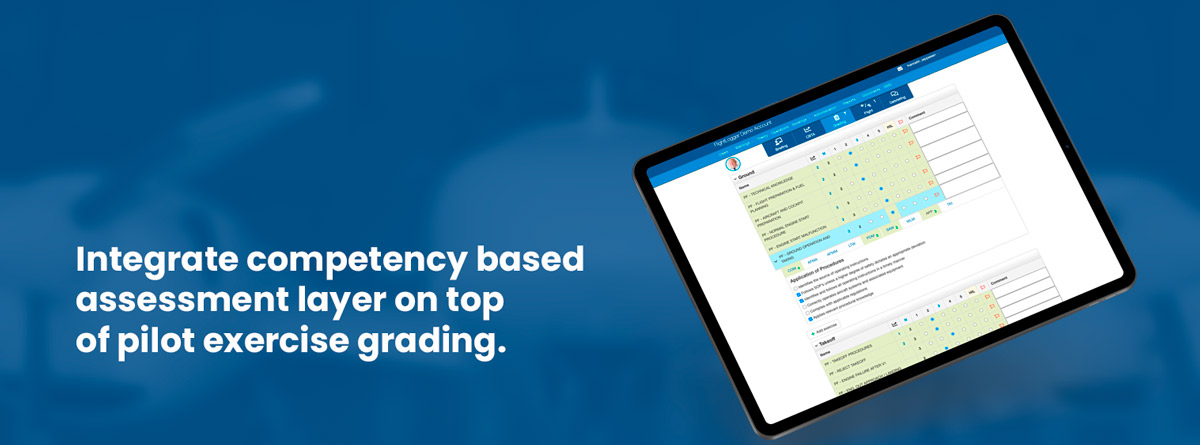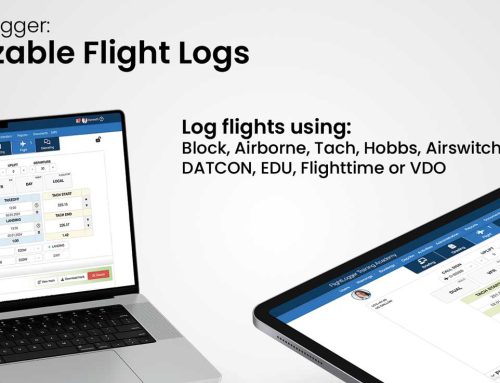Already recognized and supported by a large number of airlines, the Competency Based Training and Assessment (CBTA) method has proven its worth in terms of training effectiveness and quality for the pilots emerging from it.
Still, many flight school management systems don’t support a competency-based – or even evidence-based – approach to flight training. A few vendors claim to offer a CBTA system, but most of them don’t really help the schools a lot. The lack of systems that support the CBTA method means many pilot schools have difficulties getting started on the evidence-based training methods they otherwise see to be of great potential.
At least until now.
FlightLogger CBTA Pro facilitates competency-based training
FlightLogger is among the first flight school management systems to offer advanced CBTA functionality, also for ab initio pilot training organizations. This month, the first version of FlightLogger’s CBTA Pro was launched worldwide.
The brand-new FlightLogger CBTA Pro allows pilot training organizations to perform evidence-based training and assessment to produce quality pilots that are better prepared for the challenges caused by the growing sophistication and automation of handling an aircraft. In this post we’ll explain the basics of FlightLogger CBTA Pro.
But first, here’s a bit of background information on the CBTA method.
What is the CBTA method?
In short, the CBTA method represents a framework where pilots are trained and assessed to meet specific standards based on competencies instead of merely the ability to perform certain tasks according to defined procedures.
The move from traditional pilot training to CBTA means a shift of focus from certain skillsets to a number of core competencies, defined as the ability to “mobilize relevant knowledge, skills and aptitudes to carry out activities or tasks under specific conditions”.
Central in CBTA are the principles of evidence-based training where the use of statistical tools and data is fundamental.
History of the CBTA framework
The principles behind CBTA go all the way back to the 1970s when NASA began studying the role of human factors in aircraft accidents. Until then, aircraft accidents had been explained as caused by either mechanical, environmental or systematic issues, or simply by “pilot error”, without any exploration as to what caused the pilot error. To reduce the unacceptable accident rates seen during that time period, NASA identified the importance of addressing the role that humans played in these accidents.
The studies performed by NASA inspired FAA’s development of the Advanced Qualification Program (AQP) – a widely used system at flight schools across the US today. AQP incorporates human factor evidence-based training through the use of statistical tools to measure and identify what part of a training program is working and what needs improvement, thereby moving away from the merely rigid focus on regulatory training requirements.
Later on, ICAO borrowed the principles of AQP to further improve the outcome of evidence-based training, by focusing on a more individual assessment of pilots from a job-function-related competencies perspective that went further than just assessing technical knowledge – all based on data analysis. ICAO defined a set of technical and non-technical competencies encompassing aptitudes, behaviors and skills to be able to develop reliability, resilience and critical thinking.
Based on the previous experiences from NASA, FAA and ICAO, EASA developed the regulatory CBTA framework as we know it today in just two years. Today, pilot schools are increasingly integrating the CBTA method across Europe and emerging markets in Asia, Africa and the Middle East – but as mentioned, the struggle to find suited flight school management software that supports CBTA has so far been a major issue.
Why is CBTA so important?
The CBTA framework derives from a wish to provide pilot graduates with the competencies to be safe and highly effective in the performance of their duties by the use of evidence-based training principles.
According to ICAO, there are six main reasons why CBTA matters:
- It enables individuals to reach their highest level of operational capability while ensuring a basic level of competence as a minimum standard
- It enables individuals to cope with predictable and unforeseen situations.
- It is relevant to the job and the context in which the job will be performed
- It is geared towards learning rather than passing a test
- It makes full use of available training tools and methodologies
- It supports continuous learning and performance improvement

Evidence-based training with FlightLogger CBTA Pro
So, let’s take a look at the new FlightLogger CBTA Pro. Put simply, the new addition puts a customized competency layer on top of the existing exercises that are used in a lesson during a school flight. This way an instructor is easily lead into a competency-based assessment tool that, besides exercises, helps instructors evaluate their students on the most essential core competencies for the flight crew.
Schools using FlightLogger CBTA Pro get evidence-based knowledge in their assessment data which is automatically picked up from each lesson and accumulated into an easy-to-read matrix. The matrix gives the instructor a very fast and easy to read impression of the student’s current state in terms of core competencies across each flight phase. The CBTA matrix automatically highlights the core competencies where a particular student either under- or over performs.
This way, instructors, relevant staff and the students themselves can closely follow the student’s progress in terms of core competencies along with the traditional exercise-based gradings. It also becomes easier for a school to identify students’ problem areas from a competencies perspective.
And that’s not all. Later on, the plan for FlightLogger is to allow schools to also view statistics on core competencies across the entire school to identify overall strengths and weaknesses of particular training programs – or even instructors.
Train pilots using EASA standards – or any other standard
By default, FlightLogger CBTA Pro is configured to align with the EASA standards. This means it operates with the eight core competencies for flight crew defined by ICAO:
- Communication
- Aircraft Flight Path Management – Manual Control
- Aircraft Flight Path Management – Automation
- Leadership and Teamwork
- Problem Solving and Decision Making
- Application of Procedures
- Workload Management
- Situational Awareness
Underneath each core competency, FlightLogger also supports their underlying performance indicators according to EASA standards, meaning flight schools can dig even deeper into why certain core competencies are either below or above standards.
If preferred, schools can choose to define their own competencies and performance indicators to assess within FlightLogger.
Get an introduction to FlightLogger CBTA Pro
Whether your flight school has already implemented the CBTA method or not, the FlightLogger training management platform is a valuable companion to any flight school, its administrators, instructors, students and other staff.
To get a good impression on how FlightLogger CBTA Pro simplifies the implementation of a CBTA framework within your school – or supports your existing CBTA framework – we recommend you book an online presentation of the FlightLogger platform.
Learn more about FlightLogger CBTA Pro here – or click below to book an online demo.





